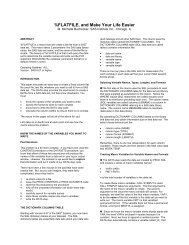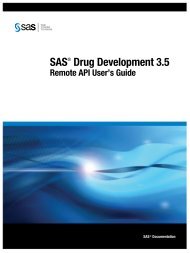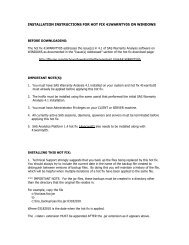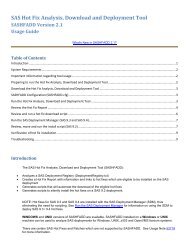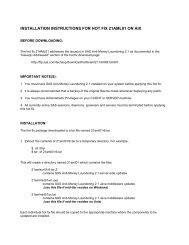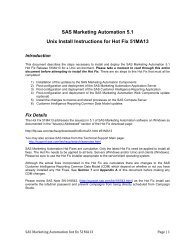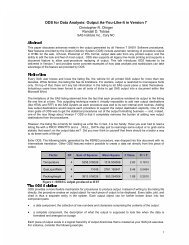C Socket Programming Tutorial- Writing Client/Server Programs in C ...
C Socket Programming Tutorial- Writing Client/Server Programs in C ...
C Socket Programming Tutorial- Writing Client/Server Programs in C ...
Create successful ePaper yourself
Turn your PDF publications into a flip-book with our unique Google optimized e-Paper software.
C <strong>Socket</strong> <strong>Programm<strong>in</strong>g</strong> <strong>Tutorial</strong> SHARE Session 5958<br />
<strong>Writ<strong>in</strong>g</strong> <strong>Client</strong>/<strong>Server</strong> <strong>Programs</strong> <strong>in</strong> C<br />
Us<strong>in</strong>g <strong>Socket</strong>s (A <strong>Tutorial</strong>)<br />
Part I<br />
Session 5958<br />
Greg Granger<br />
grgran@sas<br />
sas.com<br />
SAS Slide 1<br />
Institute Inc.<br />
SAS/C & C++ Compiler R&D<br />
Cary, NC Feb. 1998<br />
Cary, NC<br />
SAS/C & C++ Support<br />
SAS Institute<br />
Cary, NC
C <strong>Socket</strong> <strong>Programm<strong>in</strong>g</strong> <strong>Tutorial</strong> SHARE Session 5958<br />
Part I: <strong>Socket</strong> <strong>Programm<strong>in</strong>g</strong> Overview<br />
<strong>Socket</strong>s (to me)<br />
Network<strong>in</strong>g (or what’s natural about natural logs)<br />
TCP/IP (and what it means to your life)<br />
More <strong>Socket</strong>s (we didn’t get enough the first time)<br />
SAS Slide 2<br />
Institute Inc.<br />
SAS/C & C++ Compiler R&D<br />
Cary, NC Feb. 1998<br />
Cary, NC
C <strong>Socket</strong> <strong>Programm<strong>in</strong>g</strong> <strong>Tutorial</strong> SHARE Session 5958<br />
What is “<strong>Socket</strong>s”<br />
An Application <strong>Programm<strong>in</strong>g</strong> Interface (API) used<br />
for InterProcess Communications (IPC). [A well<br />
def<strong>in</strong>ed method of connect<strong>in</strong>g two processes,<br />
locally or across a network]<br />
Protocol and Language Independent<br />
Often referred to as Berkeley <strong>Socket</strong>s or BSD<br />
<strong>Socket</strong>s<br />
SAS Slide 3<br />
Institute Inc.<br />
SAS/C & C++ Compiler R&D<br />
Cary, NC Feb. 1998<br />
Cary, NC
C <strong>Socket</strong> <strong>Programm<strong>in</strong>g</strong> <strong>Tutorial</strong> SHARE Session 5958<br />
Connections and Associations<br />
In <strong>Socket</strong> terms a connections between two<br />
processes <strong>in</strong> called an association.<br />
An association can be abstractly def<strong>in</strong>ed as a 5-<br />
tuple which specifies the two processes and a<br />
method of communication. For example:<br />
• {protocol, local-addr, local-process, foreign-addr, foreign-process}<br />
A half-association is a s<strong>in</strong>gle “side” of an<br />
association (a 3-tuple<br />
tuple)<br />
• {protocol, addr, process}<br />
SAS Slide 4<br />
Institute Inc.<br />
SAS/C & C++ Compiler R&D<br />
Cary, NC Feb. 1998<br />
Cary, NC
C <strong>Socket</strong> <strong>Programm<strong>in</strong>g</strong> <strong>Tutorial</strong> SHARE Session 5958<br />
Network<strong>in</strong>g Terms<br />
packet - the smallest unit that can be transferred<br />
“through” the network by itself<br />
protocol - a set of rules and conventions between<br />
the communicat<strong>in</strong>g participants<br />
A collection of protocol layers is referred to as a<br />
“protocol suite”, “protocol family” or “protocol<br />
stack”. TCP/IP is one such protocol suite.<br />
SAS Slide 5<br />
Institute Inc.<br />
SAS/C & C++ Compiler R&D<br />
Cary, NC Feb. 1998<br />
Cary, NC
C <strong>Socket</strong> <strong>Programm<strong>in</strong>g</strong> <strong>Tutorial</strong> SHARE Session 5958<br />
Introduction to TCP/IP<br />
What (the heck) is TCP/IP<br />
Internet Protocol (IP)<br />
User Datagram Protocol (UDP)<br />
Transmission Control Protocol (TCP)<br />
TCP/IP Applications<br />
Name Resolution Process<strong>in</strong>g<br />
TCP/IP Network Diagram<br />
SAS Slide 6<br />
Institute Inc.<br />
SAS/C & C++ Compiler R&D<br />
Cary, NC Feb. 1998<br />
Cary, NC
C <strong>Socket</strong> <strong>Programm<strong>in</strong>g</strong> <strong>Tutorial</strong> SHARE Session 5958<br />
What is TCP/IP<br />
Transmission Control Protocol/Internet Protocol<br />
A network protocol suite for <strong>in</strong>terprocess<br />
communication<br />
The protocol of the Internet<br />
Open, nonproprietary<br />
Integrated <strong>in</strong>to UNIX operat<strong>in</strong>g systems<br />
Many popular network<strong>in</strong>g applications<br />
• telnet • NFS (network file system)<br />
• X11 GUI • SMTP (mail)<br />
• www • ftp (file transfer protocol)<br />
SAS Slide 7<br />
Institute Inc.<br />
SAS/C & C++ Compiler R&D<br />
Cary, NC Feb. 1998<br />
Cary, NC
C <strong>Socket</strong> <strong>Programm<strong>in</strong>g</strong> <strong>Tutorial</strong> SHARE Session 5958<br />
TCP/IP Architectural Model<br />
Process (message)<br />
REXEC / SMTP / TELNET / FTP<br />
/ DNS / RPC / Local Apps.<br />
Transport (message)<br />
TCP<br />
UDP<br />
Network (packets)<br />
ICMP<br />
IP<br />
(R)ARP<br />
Data L<strong>in</strong>k (frames)<br />
Ethernet Token-R<strong>in</strong>g FDDI X.25<br />
SNA Hyperchannel Proprietary<br />
SAS Slide 8<br />
Institute Inc.<br />
SAS/C & C++ Compiler R&D<br />
Cary, NC Feb. 1998<br />
Cary, NC
C <strong>Socket</strong> <strong>Programm<strong>in</strong>g</strong> <strong>Tutorial</strong> SHARE Session 5958<br />
Internet Protocol (IP)<br />
Establishes a “virtual” network between hosts,<br />
<strong>in</strong>dependent of the underly<strong>in</strong>g network topology<br />
Provides “rout<strong>in</strong>g” throughout the network, us<strong>in</strong>g<br />
IP address<strong>in</strong>g. For example: 149.173.70.9<br />
Features<br />
• Best-effort packet delivery<br />
• Connectionless (stateless)<br />
• Unreliable<br />
TCP<br />
IP<br />
UDP<br />
Physical Network<br />
SAS Slide 9<br />
Institute Inc.<br />
SAS/C & C++ Compiler R&D<br />
Cary, NC Feb. 1998<br />
Cary, NC
C <strong>Socket</strong> <strong>Programm<strong>in</strong>g</strong> <strong>Tutorial</strong> SHARE Session 5958<br />
User Datagram Protocol (UDP)<br />
Application Interface to IP - Packet Oriented<br />
Establishes a “port”, which allows IP to dist<strong>in</strong>guish<br />
among processes runn<strong>in</strong>g on the same host<br />
Features resemble IP semantics<br />
• Connectionless<br />
• Unreliable<br />
• Checksums (optional)<br />
TCP<br />
IP<br />
UDP<br />
Physical Network<br />
SAS Slide 10<br />
Institute Inc.<br />
SAS/C & C++ Compiler R&D<br />
Cary, NC Feb. 1998<br />
Cary, NC
C <strong>Socket</strong> <strong>Programm<strong>in</strong>g</strong> <strong>Tutorial</strong> SHARE Session 5958<br />
Transmission Control Protocol (TCP)<br />
Connection-oriented<br />
Stream Data Transfer<br />
Reliable<br />
Flow-Control<br />
Full-Duplex<br />
TCP<br />
Suited for critical data transfer applications<br />
IP<br />
UDP<br />
Physical Network<br />
SAS Slide 11<br />
Institute Inc.<br />
SAS/C & C++ Compiler R&D<br />
Cary, NC Feb. 1998<br />
Cary, NC
C <strong>Socket</strong> <strong>Programm<strong>in</strong>g</strong> <strong>Tutorial</strong> SHARE Session 5958<br />
SAS Slide 12<br />
Institute Inc.<br />
SAS/C & C++ Compiler R&D<br />
Cary, NC Feb. 1998<br />
Cary, NC<br />
The Importance of Ports<br />
Both the TCP and UDP protocols use 16 bit<br />
identifiers called ports to uniquely identify the<br />
processes <strong>in</strong>volved <strong>in</strong> a socket.<br />
In UNIX the first 1024 ports for both protocols are<br />
called “well known ports” and are def<strong>in</strong>ed <strong>in</strong> the file<br />
/etc/services. <strong>Programs</strong> that b<strong>in</strong>d to these ports<br />
require “root” access.<br />
These numbers are managed by the Internet<br />
Assigned Numbers Authority (IANA). A complete<br />
list of these assignments and more <strong>in</strong>formation<br />
about IANA can be found <strong>in</strong> RFC 1700
C <strong>Socket</strong> <strong>Programm<strong>in</strong>g</strong> <strong>Tutorial</strong> SHARE Session 5958<br />
How stuff gets around (rout<strong>in</strong>g)<br />
TCP/IP packets are routed based on their<br />
dest<strong>in</strong>ation IP address (ex: 10.24.2.123)<br />
Packets are passed from one network segment to<br />
another by mach<strong>in</strong>es called “routers” until the<br />
packet arrives at the network segment attached to<br />
the host with the dest<strong>in</strong>ation IP address.<br />
Routers that act as gates to larger networks are<br />
called gateways.<br />
SAS Slide 13<br />
Institute Inc.<br />
SAS/C & C++ Compiler R&D<br />
Cary, NC Feb. 1998<br />
Cary, NC
C <strong>Socket</strong> <strong>Programm<strong>in</strong>g</strong> <strong>Tutorial</strong> SHARE Session 5958<br />
<br />
<br />
<br />
<br />
<br />
<br />
Name Resolution Process<strong>in</strong>g<br />
Associates an IP address to a “name” (hostname)<br />
Structured method of identify<strong>in</strong>g hosts with<strong>in</strong> an <strong>in</strong>ternet<br />
The Doma<strong>in</strong> Name System (DNS) implements a hierarchical<br />
nam<strong>in</strong>g scheme which maps names like “mvs“<br />
mvs.sas.com” to<br />
an IP address<br />
DNS is implemented by a set of cooperat<strong>in</strong>g servers<br />
Mach<strong>in</strong>es that process DNS requests are called nameservers<br />
A set of library rout<strong>in</strong>es called “the resolver” ” provide the<br />
logic to query nameservers<br />
SAS Slide 14<br />
Institute Inc.<br />
SAS/C & C++ Compiler R&D<br />
Cary, NC Feb. 1998<br />
Cary, NC
C <strong>Socket</strong> <strong>Programm<strong>in</strong>g</strong> <strong>Tutorial</strong> SHARE Session 5958<br />
TCP Ports<br />
TCP/UDP/IP Diagram<br />
64K<br />
Dev1.sas.com<br />
(149.179.3.3)<br />
REXEC<br />
<strong>Server</strong><br />
port 512<br />
1023<br />
Well-known Ports<br />
0<br />
0<br />
Well-known Ports<br />
1023<br />
IP Rout<strong>in</strong>g<br />
REXEC client<br />
REXEC client<br />
Dev2.sas.com<br />
(149.179.83.6)<br />
UDP Ports<br />
64K<br />
<strong>in</strong>ternet<br />
<strong>Server</strong>1.net.sas.com<br />
(149.193.2.194)<br />
Name<strong>Server</strong><br />
SAS Slide 15<br />
Institute Inc.<br />
SAS/C & C++ Compiler R&D<br />
Cary, NC Feb. 1998<br />
Cary, NC
C <strong>Socket</strong> <strong>Programm<strong>in</strong>g</strong> <strong>Tutorial</strong> SHARE Session 5958<br />
Back to <strong>Socket</strong>s<br />
<strong>Socket</strong> Def<strong>in</strong>ition and Components<br />
<strong>Socket</strong> Library Functions<br />
Primary <strong>Socket</strong> Header Files<br />
Sample <strong>Client</strong>/<strong>Server</strong> Dialog<br />
Ancillary <strong>Socket</strong> Topics<br />
Beyond <strong>Socket</strong>s<br />
SAS Slide 16<br />
Institute Inc.<br />
SAS/C & C++ Compiler R&D<br />
Cary, NC Feb. 1998<br />
Cary, NC
C <strong>Socket</strong> <strong>Programm<strong>in</strong>g</strong> <strong>Tutorial</strong> SHARE Session 5958<br />
Def<strong>in</strong>ition and Components<br />
<strong>Socket</strong> - endpo<strong>in</strong>t of communication<br />
<strong>Socket</strong>s - An application programm<strong>in</strong>g <strong>in</strong>terface<br />
(API) for <strong>in</strong>terprocess communication (IPC)<br />
Attributes:<br />
• Protocol Independent<br />
• Language Independent<br />
• <strong>Socket</strong>s implies (not requires) TCP/IP and C<br />
<strong>Socket</strong> and Connection Association<br />
• A local host can be identified by it’s protocol, IP address and port.<br />
• A connection adds the IP address & port of the remote host.<br />
SAS Slide 17<br />
Institute Inc.<br />
SAS/C & C++ Compiler R&D<br />
Cary, NC Feb. 1998<br />
Cary, NC
C <strong>Socket</strong> <strong>Programm<strong>in</strong>g</strong> <strong>Tutorial</strong> SHARE Session 5958<br />
System calls<br />
SAS Slide 18<br />
Institute Inc.<br />
SAS/C & C++ Compiler R&D<br />
Cary, NC Feb. 1998<br />
Cary, NC<br />
• startup / close<br />
• data transfer<br />
• options control<br />
• other<br />
<strong>Socket</strong> Library Function<br />
Network configuration lookup<br />
• host address<br />
• ports for services<br />
• other<br />
Utility functions<br />
• data conversion<br />
• address manipulation<br />
• error handl<strong>in</strong>g
C <strong>Socket</strong> <strong>Programm<strong>in</strong>g</strong> <strong>Tutorial</strong> SHARE Session 5958<br />
<br />
<br />
<br />
<br />
<br />
<br />
<br />
<br />
socket()<br />
b<strong>in</strong>d()<br />
listen()<br />
accept()<br />
Primary <strong>Socket</strong> Calls<br />
- create a new socket and return its descriptor<br />
- associate a socket with a port and address<br />
- establish queue for connection requests<br />
- accept a connection request<br />
- <strong>in</strong>itiate a connection to a remote host<br />
connect() - <strong>in</strong>itiate a connection to a remote host<br />
recv()<br />
- receive data from a socket descriptor<br />
send()<br />
- send data to a socket descriptor<br />
close()<br />
- “one-way” close of a socket descriptor<br />
SAS Slide 19<br />
Institute Inc.<br />
SAS/C & C++ Compiler R&D<br />
Cary, NC Feb. 1998<br />
Cary, NC
C <strong>Socket</strong> <strong>Programm<strong>in</strong>g</strong> <strong>Tutorial</strong> SHARE Session 5958<br />
<br />
<br />
<br />
<br />
<br />
<br />
Network Database Adm<strong>in</strong>istration functions<br />
gethostbyname - given a hostname, returns a structure<br />
which specifies its DNS name(s) and IP address(es<br />
es)<br />
getservbyname - given service name and protocol, returns a<br />
structure which specifies its name(s) and its port address<br />
gethostname - returns hostname of local host<br />
getservbyname, getservbyport, getservent<br />
getprotobyname, getprotobynumber, getprotobyent<br />
getnetbyname, getnetbyaddr, getnetent<br />
SAS Slide 20<br />
Institute Inc.<br />
SAS/C & C++ Compiler R&D<br />
Cary, NC Feb. 1998<br />
Cary, NC
C <strong>Socket</strong> <strong>Programm<strong>in</strong>g</strong> <strong>Tutorial</strong> SHARE Session 5958<br />
<br />
<br />
<br />
<br />
<br />
<strong>Socket</strong> Utility Functions<br />
ntohs/ntohl<br />
ntohl - convert short/long from network byte order<br />
(big endian) ) to host byte order<br />
htons/htonl<br />
htonl - convert short/long from host byte order to<br />
network byte order<br />
<strong>in</strong>et_ntoa<br />
ntoa/<strong>in</strong>et_addr<br />
- convert 32-bit IP address (network<br />
byte order to/from a dotted decimal str<strong>in</strong>g)<br />
perror() - pr<strong>in</strong>t error message (based on “errno“<br />
errno”) to stderr<br />
herror() - pr<strong>in</strong>t error message for gethostbyname() to stderr<br />
(used with DNS)<br />
SAS Slide 21<br />
Institute Inc.<br />
SAS/C & C++ Compiler R&D<br />
Cary, NC Feb. 1998<br />
Cary, NC
C <strong>Socket</strong> <strong>Programm<strong>in</strong>g</strong> <strong>Tutorial</strong> SHARE Session 5958<br />
<br />
Primary Header Files<br />
Include file sequence may affect process<strong>in</strong>g (order is<br />
important!)<br />
• <br />
- prerequisite typedefs<br />
• <br />
- names for “errno“<br />
errno” ” values (error numbers)<br />
- struct sockaddr; ; system prototypes and constants<br />
• <br />
• <br />
• <br />
• <br />
- network <strong>in</strong>fo lookup prototypes and structures<br />
- struct sockaddr_<strong>in</strong>; byte order<strong>in</strong>g macros<br />
- utility function prototypes<br />
SAS Slide 22<br />
Institute Inc.<br />
SAS/C & C++ Compiler R&D<br />
Cary, NC Feb. 1998<br />
Cary, NC
C <strong>Socket</strong> <strong>Programm<strong>in</strong>g</strong> <strong>Tutorial</strong> SHARE Session 5958<br />
Sample TCP <strong>Client</strong> / <strong>Server</strong> Session<br />
Iterative <strong>Server</strong><br />
socket()<br />
b<strong>in</strong>d()<br />
Remote <strong>Client</strong><br />
socket()<br />
listen()<br />
gethostbyname()<br />
accept()<br />
connect()<br />
recv()/send()<br />
recv()/send()<br />
close()<br />
close()<br />
SAS Slide 23<br />
Institute Inc.<br />
SAS/C & C++ Compiler R&D<br />
Cary, NC Feb. 1998<br />
Cary, NC
C <strong>Socket</strong> <strong>Programm<strong>in</strong>g</strong> <strong>Tutorial</strong> SHARE Session 5958<br />
<br />
<br />
<br />
<br />
<br />
Ancillary <strong>Socket</strong> Topics<br />
UDP versus TCP<br />
Controll<strong>in</strong>g/manag<strong>in</strong>g socket characteristics<br />
• get/setsockopt<br />
setsockopt() - keepalive, , reuse, nodelay<br />
• fcntl() - async signals, block<strong>in</strong>g<br />
• ioctl() - file, socket, rout<strong>in</strong>g, <strong>in</strong>terface options<br />
Block<strong>in</strong>g versus Non-block<strong>in</strong>g socket<br />
Signal based socket programm<strong>in</strong>g (SIGIO)<br />
Implementation specific functions<br />
SAS Slide 24<br />
Institute Inc.<br />
SAS/C & C++ Compiler R&D<br />
Cary, NC Feb. 1998<br />
Cary, NC
C <strong>Socket</strong> <strong>Programm<strong>in</strong>g</strong> <strong>Tutorial</strong> SHARE Session 5958<br />
<br />
<br />
<br />
<br />
Design Considerations<br />
Data representation and conversion<br />
<strong>Server</strong> design alternatives<br />
Security Issues<br />
Portability Considerations<br />
SAS Slide 25<br />
Institute Inc.<br />
SAS/C & C++ Compiler R&D<br />
Cary, NC Feb. 1998<br />
Cary, NC
C <strong>Socket</strong> <strong>Programm<strong>in</strong>g</strong> <strong>Tutorial</strong> SHARE Session 5958<br />
<br />
<br />
<br />
<br />
<br />
Data Representation<br />
Transport Protocols detail data exchange/movement;<br />
applications must <strong>in</strong>terpret the data!<br />
Byte order affects data - not just addresses<br />
Text is often sent <strong>in</strong> ASCII, but ASCII versus EBCDIC is<br />
decided by the application-level protocol<br />
Structure alignment and float<strong>in</strong>g po<strong>in</strong>t pose problems<br />
External Data Representation (XDR) can be used (even<br />
without RPC)<br />
SAS Slide 26<br />
Institute Inc.<br />
SAS/C & C++ Compiler R&D<br />
Cary, NC Feb. 1998<br />
Cary, NC
C <strong>Socket</strong> <strong>Programm<strong>in</strong>g</strong> <strong>Tutorial</strong> SHARE Session 5958<br />
<br />
<br />
<br />
SAS Slide 27<br />
Institute Inc.<br />
SAS/C & C++ Compiler R&D<br />
Cary, NC Feb. 1998<br />
Cary, NC<br />
S<strong>in</strong>gle Threaded<br />
• more complex code (must track multiple concurrent requests)<br />
• generally lower system overhead<br />
• crash of thread disables service<br />
Multi-Task<strong>in</strong>g<br />
• less complex code (written only for handl<strong>in</strong>g only one connection)<br />
• higher system overhead (each task requires it’s own process space)<br />
• highly crash resistant (one or more tasks can fail without los<strong>in</strong>g<br />
service)<br />
[Multi-]Threaded<br />
<strong>Server</strong> Design Alternatives<br />
• shares less complex code of Multi-Task<strong>in</strong>g model<br />
• system overhead between S<strong>in</strong>gle-Threaded and Multi-Task<strong>in</strong>g model<br />
• crash resistant (but one badly behaved thread ‘can’ crash service)
C <strong>Socket</strong> <strong>Programm<strong>in</strong>g</strong> <strong>Tutorial</strong> SHARE Session 5958<br />
<br />
<br />
<br />
<br />
Security Considerations<br />
<strong>Socket</strong> semantics do NOT address security problems, such<br />
as:<br />
• IP and adapter addresses<br />
• Userid and passwords<br />
• data encryption<br />
• traces<br />
UNIX systems require “root” privilege when a program b<strong>in</strong>ds<br />
a “reserved” (
C <strong>Socket</strong> <strong>Programm<strong>in</strong>g</strong> <strong>Tutorial</strong> SHARE Session 5958<br />
Limit applications to “standard” socket rout<strong>in</strong>es, BSD 4.x<br />
Implement a portable transport module<br />
Ma<strong>in</strong>frame Environment - Distribute exist<strong>in</strong>g applications<br />
<br />
<br />
Portability Considerations<br />
• API Programmer’s Reference - Details<br />
• SAS/C, C/370, Interl<strong>in</strong>k, , Open Connect, NSC<br />
OS/2 - REXX <strong>Socket</strong>s, Programmer’s Toolkit<br />
MS W<strong>in</strong>dows <strong>Socket</strong>s 1.1 - 2 WINSOCK.DLL<br />
(http://www.stardust.com ftp.stardust.com:/pub/w<strong>in</strong>sock<br />
w<strong>in</strong>sock)<br />
SAS Slide 29<br />
Institute Inc.<br />
SAS/C & C++ Compiler R&D<br />
Cary, NC Feb. 1998<br />
Cary, NC
C <strong>Socket</strong> <strong>Programm<strong>in</strong>g</strong> <strong>Tutorial</strong> SHARE Session 5958<br />
<br />
<br />
<br />
<br />
Summary<br />
Basic network<strong>in</strong>g and features of TCP/IP protocols<br />
<strong>Socket</strong> library organization<br />
<strong>Socket</strong> library cod<strong>in</strong>g techniques<br />
Awareness of more advanced topics<br />
What’s Next<br />
<br />
Session 5959 - Part II - <strong>Client</strong>/<strong>Server</strong> Application<br />
SAS Slide 30<br />
Institute Inc.<br />
SAS/C & C++ Compiler R&D<br />
Cary, NC Feb. 1998<br />
Cary, NC
C <strong>Socket</strong> <strong>Programm<strong>in</strong>g</strong> <strong>Tutorial</strong> SHARE Session 5958<br />
Bibliography<br />
Internetwork<strong>in</strong>g with TCP/IP: Volumes I, II & III, Douglas<br />
Comer, Prentice Hall, 1991 (ISBN Vol I: 0134685059, Vol<br />
III: 0138487146)<br />
The Whole Internet User’s Guide & Catalog by Ed Kroll;<br />
O’Reilly & Associates<br />
UNIX Network <strong>Programm<strong>in</strong>g</strong> by W. Richard Stevens;<br />
Prentice Hall, 1990 (ISBN 0139498761)<br />
<strong>Socket</strong> API Programmer’s Reference<br />
UNIX “man” pages<br />
TCP/IP Illustrated: Volumes 1 & 2, W. Richard Stevens (v2<br />
with Gary R. Wright); Addison-Wesley Publish<strong>in</strong>g Company,<br />
1994<br />
SAS Slide 31<br />
Institute Inc.<br />
SAS/C & C++ Compiler R&D<br />
Cary, NC Feb. 1998<br />
Cary, NC





